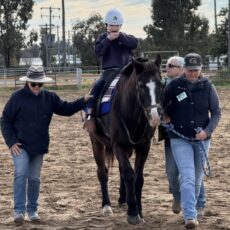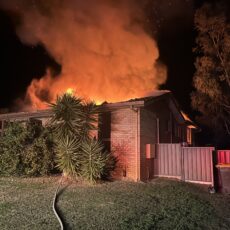The recent rain changed the catastrophic bushfire scenario along the east coast but fierce fires were still burning right up to the start of the recent rainfall in southern NSW.
Many Narrabri firefighters and emergency services personnel have been engaged in the bushfire battles at many NSW centres for several months.
On Monday afternoon, the last Narrabri Fire and Rescue tanker returned to Narrabri from Queanbeyan.
The Canberra district has now received about 100mm of rain.
A Narrabri crew had been engaged in firefighting around the Queanbeyan and Bredbo areas from Wednesday, January 29 on a seven day deployment as part of Strike Team ‘Echo’ which comprised fire trucks from Narrabri, Gunnedah, Wauchope and Laurieton.
At midday on February 1, the strike team was tasked to assist the Rural Fire Service to prevent a fire from crossing the Monaro Highway between Queanbeyan and Bredbo (south).
“By 1.30pm it was dark – the sky was pitch black,” said the Strike Team leader Narrabri’s Jason Anderson.”
At 3pm on February 3, the strike team was sent to a report of houses under ember attack at Riverview Lane, Collington.
Trucks were split up and each tasked to a property for fire protection.
As the fire advanced, the Narrabri crew was directly responsible for saving two houses that came under heavy attack from all directions.
“There were two houses 30 metres apart on the peak of a hill,” said Jason.
“The fire was coming up one side and then the other side, and then changed again.
“The house owners would have thought they were fairly secure from fires, on top of the hill, no big trees around the house, but those homes definitely would have been gone,” he said.
“We had 60 kmh winds and constant wind direction changes.
“We had difficulty accessing water and also had our pump on the appliance fail in the middle of the battle.”
A difficult job had suddenly become even more stressful.
The throttle cable snapped but they were able to fix it.
“Luckily we used some bush engineering and managed to get back operational quickly and prevent any damage two both houses and out buildings and sheds,” said Jason.
“In my ten years as a retained firefighter at Narrabri this particular day was some of the worst and hardest conditions I have ever had to work in,” he added.
The embers from fires travel far and wide and circumstances can change very dramatically.
“Ember attacks can change it in seconds and firefighters have to be prepared to cut and run,” said Jason.
“We had our exit strategy ready but didn’t need it.
Embers travel far and fast and firefighters are bombarded.
Like all the firefighters engaged in the various battles, Jason and the crew has ember burns on their garments.
Photos show the fire steadily burning its way up the hill through African love grass, a tough densely tufted grass, towards the houses.
“Lovegrass is very hard to extinguish,” said Jason.
“A garden hose would normally be all that’s needed to put out grass here but we had to use our hoses and give it a good soaking to put it out.”
“Our crew and the three affected house residents had an exit strategy but the crew did an outstanding job in the worst conditions and this was not needed.
Narrabri Fire and Rescue personnel have been busy at fires across the state.
This was Jason Anderson’s sixth deployment this season, fighting fires at centres including Inverell, Glen Innes, Jindabyne and Canberra.
Fortunately he said, he had taken a month off. Jason is a pistol enthusiast, a member of Narrabri Pistol Club and one of the successful NSW Silhouette team and came second outright to the current world champion, Australian Matt Sears at the end of last year.
Ironically, he was with colleagues tasked to protect the Inverell Pistol club when it was threatened by fire – a range at which he has recently competed.
To order photos from this page click here










